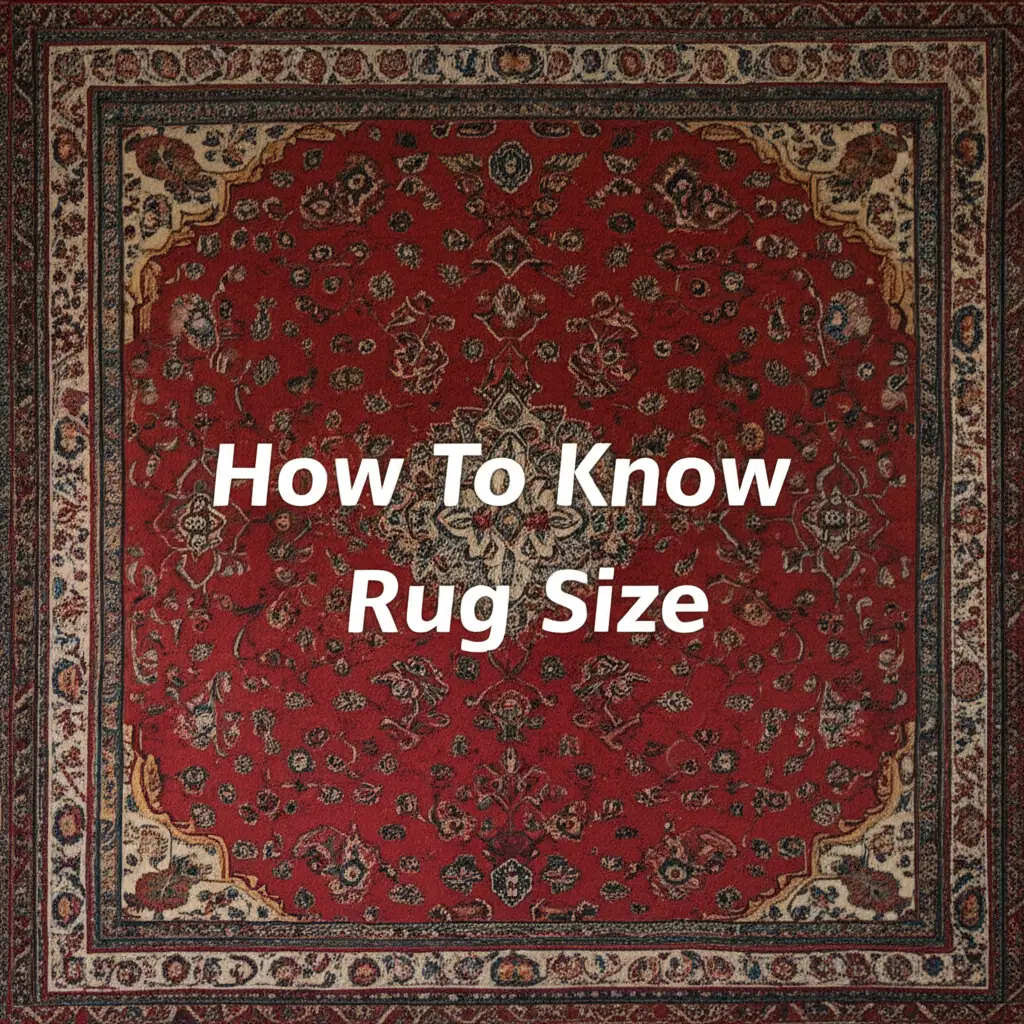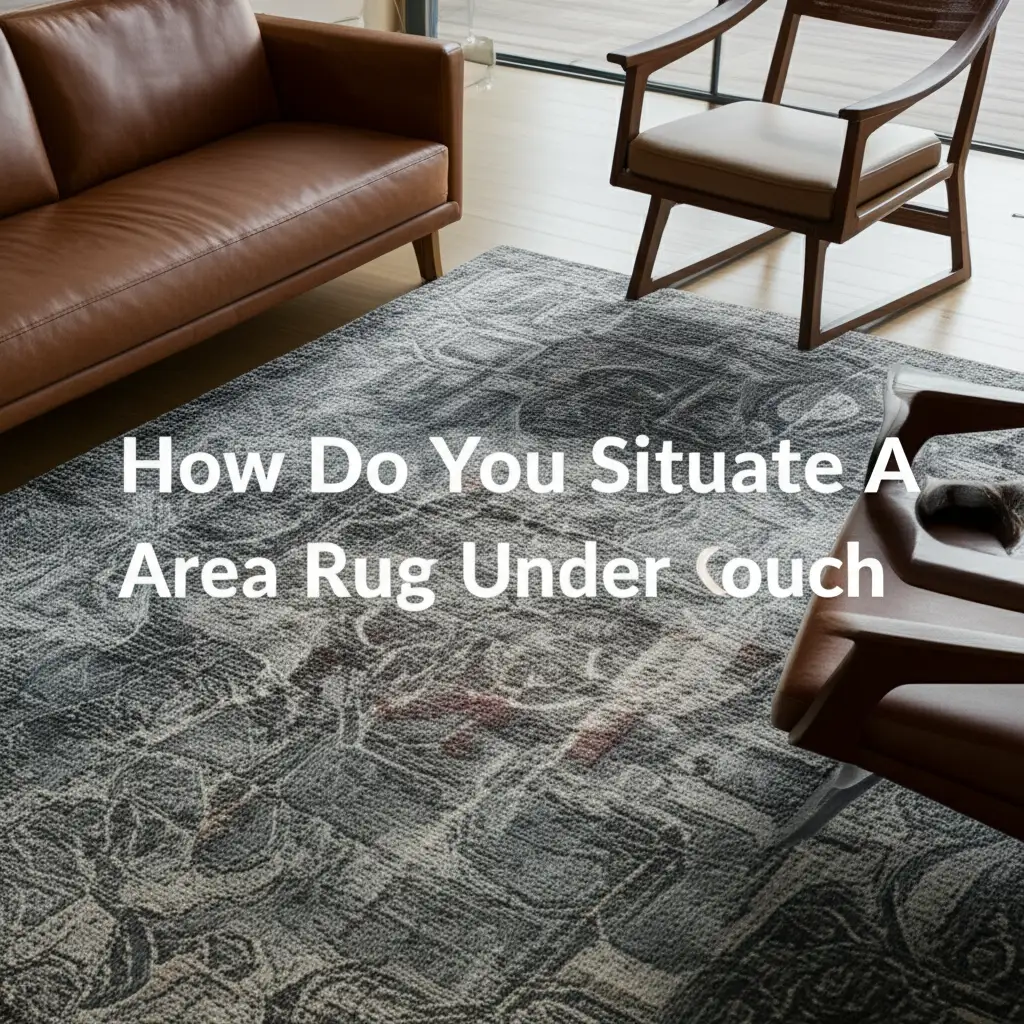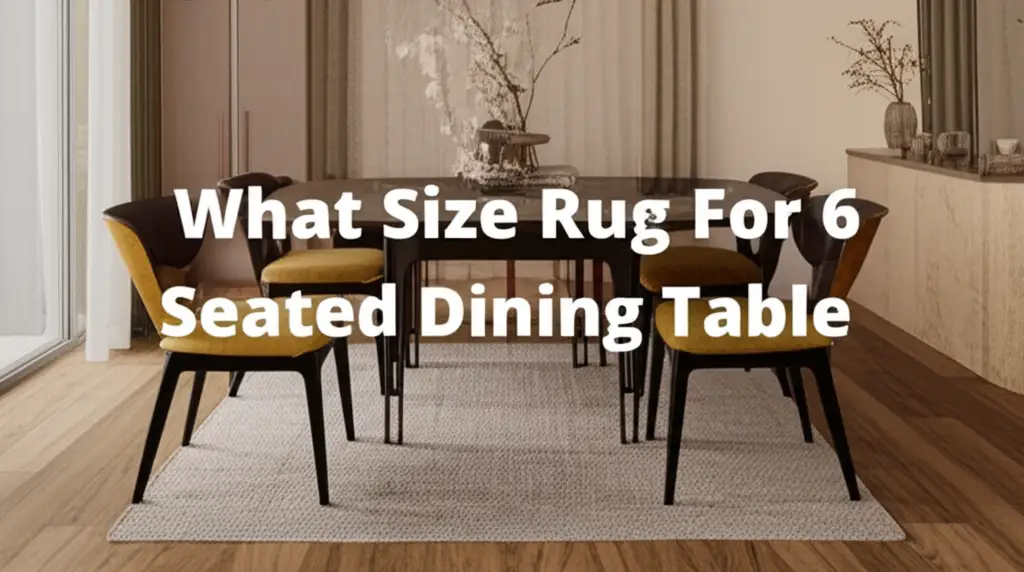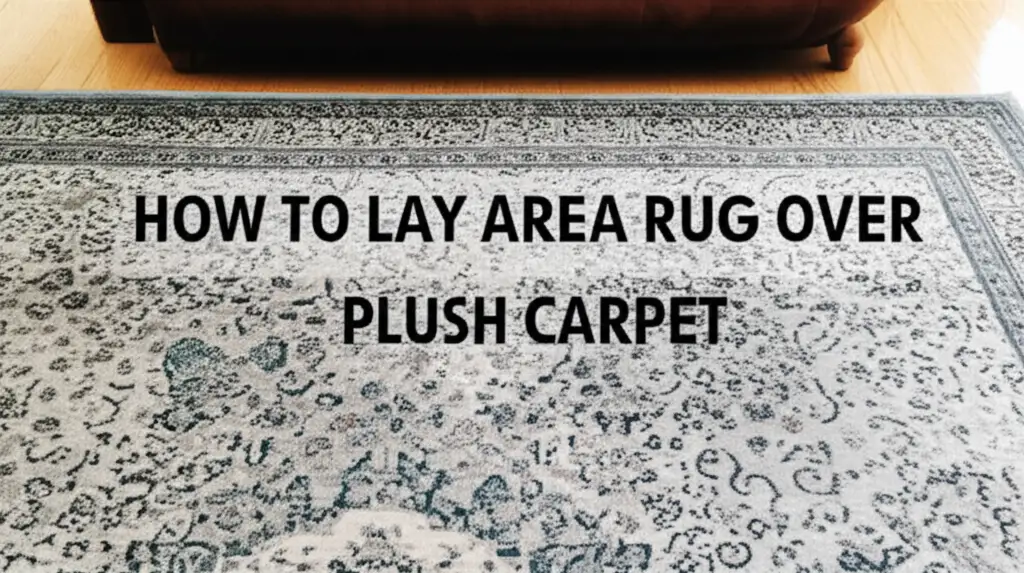· Liora Benning · Home Decor · 17 min read
How To Know Rug Size

How To Know Rug Size: A Guide to Perfect Dimensions
Choosing the right rug can change a room entirely. A rug adds warmth, defines spaces, and ties furniture together. However, picking the wrong size rug makes a room feel off. When I first started decorating, I made mistakes with rug sizes. I learned quickly that knowing how to know rug size is key.
This guide helps you pick the right rug every time. We will cover standard rug dimensions and how they fit in different rooms. You will learn to measure your space accurately. We also discuss common mistakes and how to avoid them. By the end, you will confidently select the ideal rug size for your home.
Takeaway
- Measure first: Always measure your room and furniture layout before buying a rug.
- Define areas: Use rugs to create distinct zones in open-plan spaces.
- Balance furniture: Ensure the rug relates well to the furniture it surrounds or sits under.
- Room specific rules: Apply different sizing guidelines for living rooms, dining rooms, and bedrooms.
- Consider traffic: Think about how people move through the space when choosing a rug.
How do you know the correct rug size for a room?
You know the correct rug size by measuring your room and considering your furniture layout. The rug should define the space, allowing furniture to sit fully on it or with front legs on it. It should leave equal floor space around its edges, creating a balanced look.
Understanding Room Layouts and Furniture Placement
Every room has its own flow and purpose. The furniture arrangement in a room guides your rug size choice. A rug should enhance your room’s design, not detract from it. Think of your rug as the foundation for your decor.
When you begin, look at your existing furniture. See how it sits in the room. Note where pathways are and where seating areas exist. The rug needs to fit these paths and areas.
The Role of Rugs in Defining Space
Rugs are powerful tools for defining areas. In open-concept homes, a rug can clearly mark a living room area from a dining space. It helps separate functions without needing walls. This creates distinct zones that feel organized and complete.
Imagine a large room with a sofa and chairs. A rug under these pieces instantly creates a cozy conversation area. Without the rug, the furniture might feel scattered. The rug gathers everything, making the space feel purposeful.
How Furniture Affects Rug Choice
The size of your furniture directly impacts the rug size you need. Large sofas or multiple seating pieces require bigger rugs. Small accent chairs or a single reading nook might only need a small rug. The goal is for the rug to ground the furniture.
For living rooms, the rug should be large enough to at least fit the front legs of all main seating pieces. This helps visually connect them. If a rug is too small, it looks like a floating island, which is not good. My advice is to always go slightly larger if you are unsure.
Standard Rug Sizes and Their Uses
Rugs come in standard sizes, making selection easier. Knowing these common dimensions helps you narrow down options. You can then match them to your measured space. These sizes generally work well for most rooms.
Common rug sizes include 2x3, 3x5, 4x6, 5x7 or 5x8, 6x9, 8x10, and 9x12 feet. Larger rugs, like 10x14 or 12x15, are also available for big rooms. Each size serves a specific purpose in home design.
Small Rugs: 2x3 to 4x6 Feet
Small rugs are good for small spaces or specific uses. A 2x3 rug often works in an entryway or in front of a sink. It adds a touch of color or warmth without taking over. These sizes are also perfect for layering over larger rugs.
A 3x5 or 4x6 rug might fit well in a small bedroom or under a small coffee table. They are also good for defining a reading nook. I often use these sizes to add comfort in high-traffic areas. Remember, smaller rugs can sometimes make a room feel smaller if not used carefully.
Medium Rugs: 5x7 to 6x9 Feet
Medium-sized rugs are versatile. A 5x7 or 5x8 rug is popular for smaller living rooms. It can fit under a coffee table with seating around it. For an 11x11 room, a rug of this size might be perfect. You can find more specific advice on this in our guide: What Size Rug for 11x11 Room. These rugs also work well in bedrooms, under the foot of a full or queen bed.
A 6x9 rug provides more coverage. It can work in medium-sized living rooms where front furniture legs sit on the rug. It can also anchor a dining table for four to six people. This size offers a good balance between coverage and leaving floor space.
Large Rugs: 8x10 Feet and Up
Large rugs truly define a room. An 8x10 rug is a common choice for average to larger living rooms. It can accommodate a sofa and two chairs, with all furniture legs on the rug or at least the front legs. This size creates a cohesive look. For a 12x12 room, an 8x10 rug is often ideal. Check out our detailed article for more information: What Size Rug for 12x12 Room.
Rugs 9x12 feet and larger are for big spaces. They are excellent for grand living rooms or large dining rooms. For a dining table, make sure the rug extends at least 24 inches beyond the table on all sides. This allows chairs to remain on the rug when pulled out. This rule also applies to outdoor dining sets. For specific guidance on outdoor dining, see our article: What Size Outdoor Rug for 6-Person Table.
Measuring Your Space for the Perfect Rug
Accurate measurement is the most important step. Do not guess the rug size. A small mistake can lead to a rug that does not fit or looks out of place. Grab a measuring tape and take your time.
Start by measuring the entire room. Then, measure the area where you want the rug to go. Consider where furniture will sit. This helps you visualize the space the rug will fill.
Tools for Accurate Measurement
You do not need many tools. A standard tape measure is enough. Some people use painter’s tape or old sheets to mark the rug area. This lets you see the size on the floor before you buy. It helps you visualize the rug’s impact.
I always recommend using painter’s tape. Lay it down where you think the rug will go. Then, place your furniture. Walk around the marked area. This gives you a clear sense of the rug’s boundaries and how it will feel.
Step-by-Step Measuring Process
- Clear the Area: Move any small items out of the way. You need a clear floor to measure.
- Measure Room Dimensions: Measure the length and width of your room. Write these numbers down. This gives you an overall idea of the space.
- Define the Rug Area: Decide where the rug will sit. Will it be under a bed, a dining table, or a sofa?
- Measure the Rug Area: Measure the length and width of this specific area. For instance, if you want a rug under your dining table, measure the table’s dimensions. Then, add space for chairs to pull out.
- Consider Furniture Placement: Place your furniture. Then, measure the area you want the rug to cover in relation to that furniture. Remember the rule: at least the front legs on the rug for living rooms.
- Use Painter’s Tape: Outline the desired rug size with painter’s tape on the floor. Step back and look. Does it feel right? Adjust the tape until it looks balanced.
- Re-measure the Taped Area: Measure the taped area one last time. This is your target rug size.
This detailed approach ensures you select a rug that fits your space and your furniture. It saves you from returns and disappointment.
Rug Sizing by Room: Living Room, Dining Room, Bedroom
Different rooms have different needs for rug sizing. A rug that works in a living room might not work in a dining room. Understanding these room-specific guidelines helps immensely. These are general rules, but they often lead to the best results.
Think about the primary function of each room. In a living room, it’s about comfort and conversation. In a dining room, it’s about stability for chairs. In a bedroom, it’s about warmth and soft landing for your feet.
Living Room Rug Sizing
For the living room, you have a few options depending on your space and style.
- Option 1: All Legs On: This is the ideal scenario for large rooms. The rug is big enough for all your main furniture pieces to sit entirely on it. This creates a luxurious and cohesive feel. It makes the room look grander.
- Option 2: Front Legs On: This is the most common and versatile option. The rug is large enough for the front legs of your sofa and accent chairs to rest on it. This visually connects the furniture. It keeps the open feel of the room.
- Option 3: Coffee Table Only: For very small living rooms or apartments, the rug might only sit under the coffee table. This defines a small central area. However, it can make the furniture feel disconnected. Use this option only if space is truly limited.
Always leave at least 12-18 inches of bare floor between the rug’s edge and the walls. This creates a border and prevents the rug from looking like wall-to-wall carpet. It helps define the space.
Dining Room Rug Sizing
The key to a dining room rug is ensuring chairs stay on the rug even when pulled out.
- Rule of Thumb: The rug should extend at least 24 inches beyond the dining table on all sides. This allows chairs to slide back without catching the rug’s edge. This prevents tripping hazards.
- Table Shape Matters:
- Rectangular Tables: Pair with rectangular rugs (e.g., 8x10 or 9x12 for a standard table).
- Round Tables: Pair with round or square rugs. Make sure the rug diameter or side length allows for the 24-inch rule.
- Seating Capacity: For a 6-seated dining table, you will need a substantial rug. For specific recommendations, refer to our article: What Size Rug for 6-Seated Dining Table. Getting the size wrong here means constant chair snagging.
Bedroom Rug Sizing
Bedroom rugs add comfort and warmth underfoot. The size depends on your bed size.
- King Bed: A 9x12 rug is often perfect. It extends well beyond the sides and foot of the bed. It allows for nightstands to sit on it or just off it.
- Queen Bed: An 8x10 or 6x9 rug works well. An 8x10 rug allows the bed and nightstands to sit on the rug. A 6x9 rug typically extends from just under the nightstands to the foot of the bed. It still provides a soft landing.
- Full/Twin Bed: A 5x7 or 6x9 rug can be placed to extend from the middle of the bed to the foot. Or, you can place a smaller 3x5 or 4x6 rug on either side of the bed. This is good for warmth when stepping out of bed.
- No Nightstands on Rug: If you prefer your nightstands off the rug, ensure the rug starts just in front of them. It should still extend past the foot of the bed.
Entryways, Hallways, and Kitchens: Specific Sizing Tips
Beyond the main rooms, other areas also benefit from rugs. Entryways, hallways, and kitchens have unique needs. The right rug size in these areas improves function and aesthetics. They also protect your floors from heavy traffic.
Consider the narrowness of hallways and the work zones in kitchens. These spaces require careful rug selection. You want to enhance the space, not create an obstacle.
Entryway Rugs
Entryway rugs, also called welcome mats, serve a dual purpose. They trap dirt from shoes and make a first impression.
- Functionality: The rug should be large enough to allow people to step onto it, wipe their feet, and take a few steps. A common size is 2x3 or 3x5 feet.
- Door Clearance: Always check that the rug does not interfere with the door opening or closing. The pile height matters here.
- Visual Impact: The rug should not overwhelm the entry space. It should fit the scale of your foyer or landing. For more on this, see our detailed guide on How to Measure for Entryway Rug.
Hallway Runners
Hallway runners protect floors and add visual interest to long, narrow spaces.
- Length: The runner should be shorter than the hallway itself. Leave a few inches of floor showing at each end. This creates a finished look.
- Width: The runner should be narrower than the hallway. Leave at least 4-6 inches of bare floor on each side. This prevents the hallway from feeling completely carpeted.
- Multiple Runners: For very long hallways, you can use multiple runners with small gaps in between. This can break up the length visually. Ensure the gaps are consistent.
Kitchen Rugs
Kitchens need rugs that are practical and easy to clean. They provide comfort while standing.
- Sink Area: A small 2x3 or 2x4 rug is common in front of the sink. It cushions your feet while washing dishes.
- Galley Kitchens: A runner can work in a galley kitchen, especially between two opposing counters. Ensure it does not block cabinet doors or appliances.
- High-Traffic Zones: Place rugs in areas where you stand most often, like in front of the stove or island. Prioritize durability and washability for these rugs.
Common Rug Sizing Mistakes to Avoid
Even with all the guidelines, it is easy to make mistakes. Knowing these common pitfalls can help you avoid them. A rug that is the wrong size can make a room feel small, unbalanced, or unfinished. I have seen many rooms fall flat because of incorrect rug sizing.
Do not rush the decision. Take your time to measure and visualize. This effort saves you from disappointment and the hassle of returns.
The “Floating Rug” Syndrome
This is the most common mistake: choosing a rug that is too small. A rug that is too small looks like a postage stamp in the middle of the room. It makes furniture feel disconnected. It does not ground the space. This is often called “the floating rug” syndrome.
To avoid this, remember the “front legs on” or “all legs on” rule for living rooms. For dining rooms, ensure chairs stay on the rug when pulled out. A rug should feel like an anchor, not a small island. Always err on the side of larger rather than smaller.
Ignoring Room Shape and Dimensions
Another mistake is not considering the actual shape and dimensions of your room. A rectangular rug in a perfectly square room might look odd if not balanced by furniture. A rug that almost touches the walls on all sides makes the room look small and cramped. It can also make a room feel like it has wall-to-wall carpeting.
Always leave enough bare floor around the rug’s edges. This creates a border that helps define the space. For most rooms, 12-18 inches of exposed floor is a good target. This gap allows your flooring to show through and frames the rug nicely.
Forgetting About Door Clearance
This is a practical mistake. A rug that is too thick or placed too close to a door can block it. This is especially true for entryways or bedrooms. Before buying a rug, measure the clearance under your doors. If it is a low clearance, look for thin rugs or choose a size that sits away from the door swing.
Always test this with painter’s tape if you are unsure. Lay down the tape, then open the door fully. Does it clear the space? This simple check prevents a lot of frustration later.
When to Go Big or Small: Visual Impact
The size of your rug impacts the room’s visual feel. A large rug can make a room feel grand and expansive. A smaller rug can create intimacy or highlight a specific area. It is about understanding what visual impact you want to achieve.
Think about the mood you want for the room. A cozy nook might need a small, plush rug. A formal living room might benefit from a large, elegant rug.
The Power of a Large Rug
A large rug makes a room feel bigger and more cohesive. It ties all the furniture together, creating a unified look. When all the main furniture pieces sit on the rug, the space feels grounded. This is especially true in open-concept homes.
A large rug also adds warmth and reduces echo in bigger spaces. It creates a soft foundation underfoot. If you have the space and budget, a larger rug is almost always the better choice. It elevates the entire room design.
When a Smaller Rug is Best
Sometimes, a smaller rug is the right choice.
- Layering: Small rugs are great for layering over a larger, neutral rug. This adds texture and color.
- Defining Small Zones: In a large room, a small rug can define a specific, intimate zone. Think of a reading chair with a small rug under it.
- High-Traffic Points: A small rug or runner works well in areas like in front of a kitchen sink or an entryway. They offer comfort and protect floors without covering too much.
- Cost-Effectiveness: Smaller rugs are less expensive. They are a good option for adding style on a budget. However, never buy a small rug just to save money if the room calls for a large one. This will backfire.
Ultimately, the best rug size creates balance. It should make the room feel complete and inviting. It enhances the room’s function and beauty.
FAQ Section
How much space should a rug leave from the wall?
A rug should typically leave between 12 to 18 inches of bare floor between its edges and the walls. For smaller rooms, you might aim for 6 to 12 inches. This border helps frame the rug and prevents the room from feeling completely carpeted. It creates a defined area without making the room seem smaller.
Can a rug be too big for a room?
Yes, a rug can be too big for a room. If a rug extends too close to the walls, or if furniture cannot sit comfortably on or off it, it is too big. This makes the room feel cramped and unbalanced. The goal is to define a space, not to cover every inch of floor.
Should all furniture legs be on the rug?
Ideally, in a living room, all legs of major furniture pieces should sit on the rug for a grand look. However, it is more common and perfectly acceptable for only the front two legs of sofas and chairs to rest on the rug. This still creates a cohesive and anchored feel.
What if my rug is slightly too small?
If your rug is slightly too small, you can try layering it over a larger, neutral rug, such as a jute or sisal rug. This adds depth and makes the overall area appear larger. Another option is to rearrange furniture so that the small rug defines a specific, smaller zone, like a coffee table area.
How do I choose a rug for an open-concept space?
For open-concept spaces, use rugs to define distinct zones. Each functional area (e.g., living, dining) should have its own rug. Ensure these rugs are large enough to anchor the furniture within each zone. They should also complement each other in style and color, creating a unified flow.
Is it okay for rugs to overlap?
Rugs can overlap, especially when layering different sizes or textures. This adds visual interest and warmth. When overlapping, ensure the smaller rug is centered on the larger one. The colors and patterns should complement each other, creating a rich and inviting look.
Conclusion
Choosing the right rug size is a key step in home design. It transforms a room, making it feel complete and well-designed. We have explored how to know rug size by measuring your space. We have looked at standard dimensions and how they apply to different rooms. You now understand how furniture placement affects your choices.
Remember to avoid common mistakes like buying a rug that is too small. Always measure carefully and use tools like painter’s tape to visualize. Consider the visual impact a rug will have on your room. A perfectly sized rug improves aesthetics and functionality. Take these tips and apply them to your home. Start measuring today, and find the ideal rug to complete your space.





